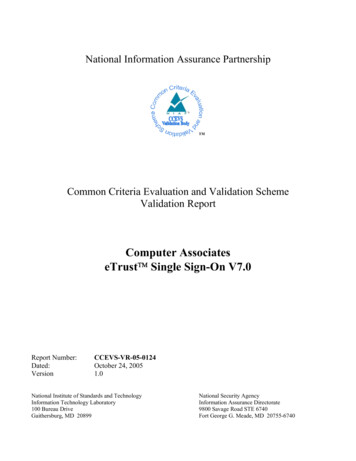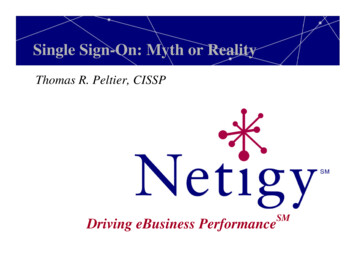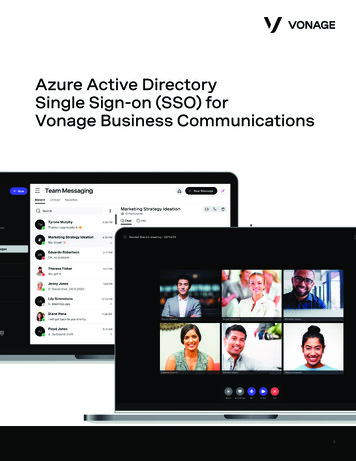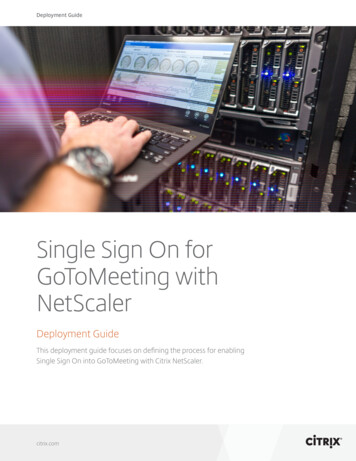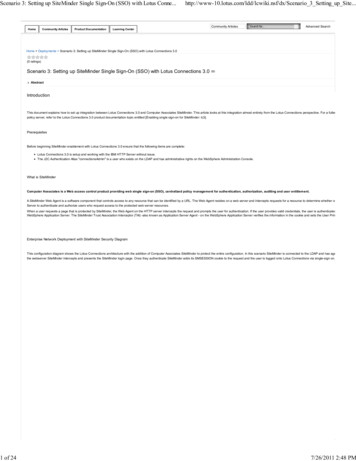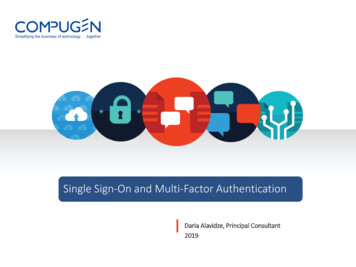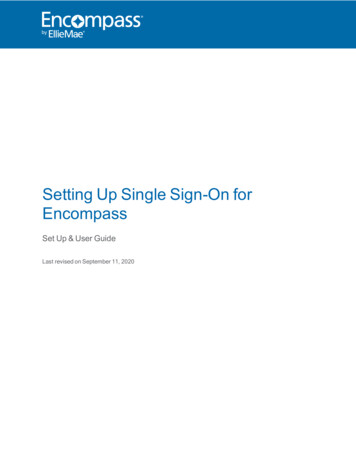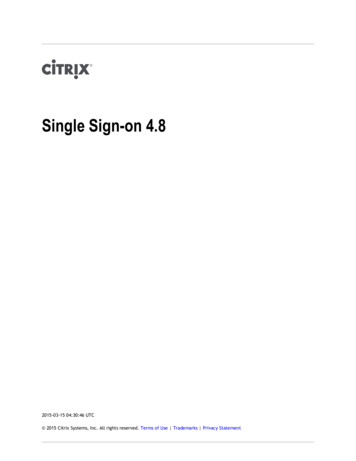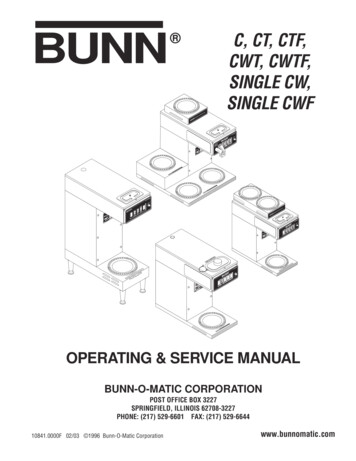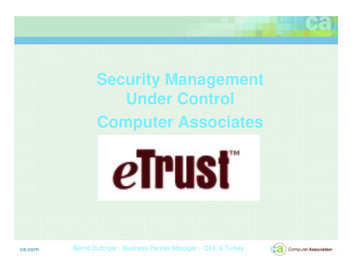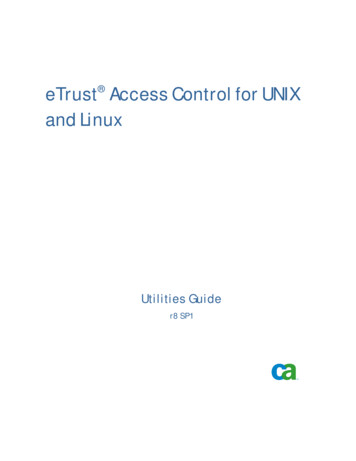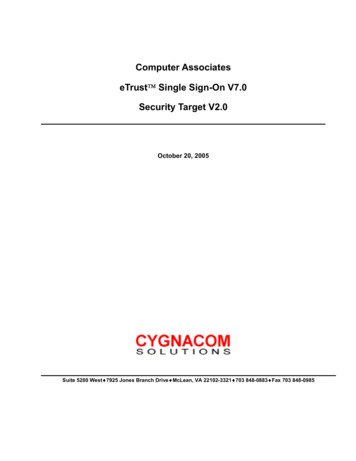
Transcription
Computer AssociateseTrust Single Sign-On V7.0Security Target V2.0October 20, 2005Suite 5200 West 7925 Jones Branch Drive McLean, VA 22102-3321 703 848-0883 Fax 703 848-0985
TABLE OF CONTENTSSECTION1SECURITY TARGET INTRODUCTION .11.11.21.31.42PRODUCT TYPE .3ETRUST SSO COMPONENTS .3TSF BOUNDARY AND SCOPE OF THE EVALUATION .4TOE FUNCTIONALITY .6IT ENVIRONMENT .7TOE SECURITY ENVIRONMENT.93.13.24SECURITY TARGET IDENTIFICATION .1SECURITY TARGET OVERVIEW .1COMMON CRITERIA CONFORMANCE .1DOCUMENT ORGANIZATION .1TOE DESCRIPTION .32.12.22.32.42.53PAGEASSUMPTIONS .9THREATS .9SECURITY OBJECTIVES.114.1SECURITY OBJECTIVES FOR THE TOE.114.2SECURITY OBJECTIVES FOR THE ENVIRONMENT .114.2.1Security Objectives for the IT Environment .114.2.2Non-IT Security Objectives .125IT SECURITY REQUIREMENTS.135.1TOE SECURITY FUNCTIONAL REQUIREMENTS .135.1.1Class FAU: Security Audit.145.1.2Class FIA: Identification and Authentication .145.1.3Class FMT: Security Management .165.1.4Class FTA: TOE Access.165.1.5Strength of Function.165.2SECURITY FUNCTIONAL REQUIREMENTS FOR THE IT ENVIRONMENT .165.2.1Class FAU: Audit .175.2.2Class FIA: Identification and Authentication .175.2.3Class FMT: Security Management .185.2.4Class FPT: Protection of the TSF.195.3TOE SECURITY ASSURANCE REQUIREMENTS .206TOE SUMMARY SPECIFICATION .216.1IT SECURITY FUNCTIONS .216.1.1Overview .216.1.2Primary Authentication.216.1.3Application Authentication .226.1.4Passwords .236.1.5Auditing.246.1.6TOE Access .246.1.7SOF Claims .246.2ASSURANCE MEASURES .25ii
7PP CLAIMS.268RATIONALE .278.1SECURITY OBJECTIVES RATIONALE .278.1.1Threats to Security .278.1.2Assumptions .308.2SECURITY REQUIREMENTS RATIONALE .318.2.1Functional Requirements .318.2.2Requirements for the IT Environment .338.2.3Dependencies .348.2.4Strength of Function.358.2.5Assurance Requirements .358.2.6Rationale that IT Security Requirements are Internally Consistent .358.2.7Rationale for Explicitly Stated Requirements .368.3TOE SUMMARY SPECIFICATION RATIONALE .368.3.1IT Security Functions .368.3.2Assurance Measures .388.4PP CLAIMS RATIONALE .40910ACRONYMS .41REFERENCES.42iii
Table Of Tables and FiguresTable or FigurePageFIGURE 2-1 – ETRUST SINGLE SIGN-ON COMPONENTS . 4FIGURE 2-2 -TOE BOUNDARY . 6FIGURE 2-3 LOGICAL VIEW OF TOE INTERFACES . 7TABLE 5-1 – SECURITY FUNCTIONAL REQUIREMENTS FOR THE TOE . 13TABLE 5-2 – SECURITY FUNCTIONAL REQUIREMENTS FOR THE IT ENVIRONMENT . 16TABLE 5-3 – MANAGEMENT OF TSF DATA . 18TABLE 5-4 – EAL2 ASSURANCE COMPONENTS . 20TABLE 8.1 – ALL THREATS TO SECURITY COUNTERED . 27TABLE 8.2 – ALL ASSUMPTIONS ADDRESSED. 30TABLE 8.3 - ALL OBJECTIVES MET BY FUNCTIONAL COMPONENTS . 31TABLE 8.5 - ALL OBJECTIVES FOR THE IT ENVIRONMENT MET BY REQUIREMENTS . 33TABLE 8.4 - ALL DEPENDENCIES SATISFIED . 34TABLE 8.6 – MAPPING OF FUNCTIONAL REQUIREMENTS TO TOE SUMMARY SPECIFICATION . 36TABLE 8.7 – ASSURANCE MEASURES RATIONALE . 38iv
1 Security Target Introduction1.1Security Target IdentificationTOE Identification: Computer Associates eTrust Single Sign-On V7.0 with patch QO67747ST Title:Computer Associates eTrust Single Sign-On V7.0 Security TargetST Version:Version 2.0ST Author:CygnaCom Solutions, Inc.ST Date:October 20, 2005Assurance level:EAL2Registration: To be filled in upon registration Keywords:Single Sign-On, Network Security, Identification, Authentication, AccessControl, Tickets, and Security Target1.2Security Target OverviewThis Security Target (ST) defines the Information Technology (IT) security requirements forComputer Associates (CA) eTrust Single Sign-On. eTrust Single Sign-On is a distributed securitysoftware product that manages passwords and other authentication mechanisms for logging intomultiple applications and hosts on a network. Single Sign-On automates the login process andeliminates a user’s need to keep track of multiple user IDs and passwords.1.3Common Criteria ConformanceThe TOE is Part 2 extended, Part 3 conformant, and meets the requirements of EvaluationAssurance Level (EAL) 2 from the Common Criteria Version 2.2.1.4Document OrganizationThe main sections of an ST are the ST Introduction, Target of Evaluation (TOE) Description, TOESecurity Environment, Security Objectives, IT Security Requirements, TOE Summary Specification,and Rationale.Section 2, the TOE Description, describes the product type and the scope and boundaries of theTOE.Section 3, TOE Security Environment, identifies assumptions about TOE’s intended usage andenvironment and threats relevant to secure TOE operation.Section 4, Security Objectives, defines the security objectives for the TOE and its environment.Section 5 specifies the TOE Security Requirements. The TOE security requirements are made upof Functional Requirements and Assurance Requirements. This section also includes SecurityRequirements for the IT Environment.Section 6, TOE Summary Specification, describes the IT Security Functions and AssuranceMeasures.1
Section 7, Protection Profile (PP) Claims, is not applicable, as this product does not claimconformance to any PP.Section 8, Rationale presents evidence that the ST is a complete and cohesive set of requirementsand that a conformant TOE would provide an effective set of IT security countermeasures within thesecurity environment. The Rationale has three main parts: Security Objectives Rationale, SecurityRequirements Rationale, and TOE Summary Specification Rationale.Acronym definitions and references are provided in the Appendices.2
2 TOE DESCRIPTION2.1Product TypeeTrust Single Sign-on (SSO) is a distributed security software product that manages passwords andother authentication mechanisms for logging into multiple applications and hosts on a network.eTrust SSO automates the login process and eliminates a user’s need to keep track of multiple userIDs and passwords.2.2eTrust SSO ComponentseTrust SSO features a central administration interface that provides central control of all SSOenabled user and application profiles. The eTrust SSO product consists of the followingcomponents: Policy Server, Policy Manager, Authentication Agent(s) and SSO Clients. Figure 2.1provides an overview of how these components are integrated.The Policy Server is a process that runs on a server host. The Policy Server is the heart of eTrustSSO. It controls eTrust SSO functions and maintains communications between the various eTrustSSO components and the secure applications that the users invoke. It also updates audit logs.The eTrust Access Control and eTrust Directory data repositories reside on the Policy Managerhost. However, these products are being separately evaluated and are part of the IT environment.eTrust Access Control is used primarily to store information about resources, applications, andaccess-control rules. eTrust Directory stores information about users, user groups, and logoninformation in an LDAP repository.The Policy Manager is GUI application that is used to manage the information stored in the PolicyServer. It is installed on an administrator's Windows workstation with TCP/IP communication to thePolicy Server.Authentication Agents are processes that run, generally, on an authentication host server andverifies user credentials with the authentication host (e.g., Windows AD domain controller or aMainframe server). Once verified, the Auth Agent creates an SSO ticket which is passed back tothe SSO Client and the SSO Client uses this ticket in any subsequent communications with thePolicy Server – the ticket verifies the authenticity of the user using the SSO Client.An SSO Client is a GUI application that runs on every user workstation. It provides a flexible andintuitive interface to the end user to enter their primary login credentials and once verified, providesautomatic access to their SSO enabled applications without need to re-enter their applicationcredentials.3
Figure 2-1 – eTrust Single Sign-On Components2.3TSF Boundary and Scope of the EvaluationThe TOE includes the following Software Components:The TOE will be installed to its evaluated configuration as shown in Figure 2.2. The evaluatedconfiguration will be on 4 separate machines which include the following: Server 1: Policy Server and Policy Manger running on one machine with Windows 2000Server SP4. Server 2: Authentication agent running on Windows 2000 Server SP4 Workstation 1: Policy Manager and SSO Client running on one machine with Windows 2000SP4. Workstation 2: SSO Client running on Windows 2000 SP4.In the evaluated configuration, LDAP authentication for primary authentication is used.The TOE is software-only and includes the Policy Server, Authentication Agent, Policy Manager,and SSO client software components.The TOE does not include the following IT Environment Components: Underlying Hardware platform(s) Underlying Operating System platform(s): Windows 2000 Server SP4 for all productcomponents eTrust Access Control v5.2 eTrust Directory 8.0 LDAP implementation LDAP client used to connect to LDAP directory SSL implementation Cryptographic modules Domain Controller used to provide a physically protected local area network.4
ApplicationsCopies of eTrust Access Control v5.2 and eTrust Directory v8.0 are embedded in the Policy Server.However, these products are being separately evaluated and are outside the scope of thisevaluation.AuthenticationAgentWindows2000 SP4TOEComponentsSSO ClientPolicyManagerServer 2Windows2000 SP4PC1DomainControllerPolicyServerWindows2000 SP4Server O ClientWindows2000 SP4PC2Windows2000 SP45Server 1
Figure 2-2 -TOE Boundary2.4TOE FunctionalityThe TOE provides the following security functionality: identification and authentication, audit, securemanagement of TOE security functions and data, session establishment, and protection of TOEsecurity functions. The main security service provided by eTrust SSO is to manage authenticationinformation securely. eTrust SSO manages passwords and other authentication information forlogging into multiple applications and hosts on a network. There are two steps of the authenticationprocess: primary authentication and application authentication.Primary authentication is the process by which the end user is authorized to use eTrust SSO. Thehost that performs primary authentication is called the authentication host. Primary authenticationis performed by an Authentication Agent running on the authentication host.The Authentication Agent verifies the credentials that the SSO Client provides, and if they are validsends an SSO ticket back to the SSO Client. The SSO Client caches the ticket and sends the ticketto the Policy Server as proof that the end user has been authenticated. . An SSO ticket is valid fora predetermined period of time.Once the end user is successfully authenticated, the SSO Client requests an application list. Theend user selects an application. The SSO Client sends the SSO ticket that it has cached on behalfof the user to the Policy Server to obtain the necessary information to login to the application. If theend user is authorized to login to the application at the time, the Policy Server sends the informationto login to the application to the SSO Client. The SSO Client authenticates the end user to theapplication.eTrust SSO provides the capability for users to create or generate passwords either for primaryauthentication when authenticating to the SSO client or for authentication to the application. ETrustcan enforce its password policy at the time that the passwords are created by the user orgenerated.eTrust SSO provides the capability of auditing the following events: primary authentication, enduser request for an application list, end user request for login variables,eTrust SSO can control the number of sessions a user can have open.Figure 2-3Figure 2-3 shows a logical view of the eTrust SSO components and interfaces.6
erInternalInterface1Data rnalInterface2eTrustAccess pplications InterfaceWindowsMainApplicationsEnd UserInterfaceEnd UserFigure 2-3 Logical View of TOE Interfaces2.5IT EnvironmentIt is assumed that there will be no untrusted users or software on the Policy Server andAuthentication Host servers. It
Computer Associates (CA) eTrust Single Sign-On. eTrust Single Sign-On is a distributed security software product that manages passwords and other authentication mechanisms for logging into multiple applications and hosts on a network.
